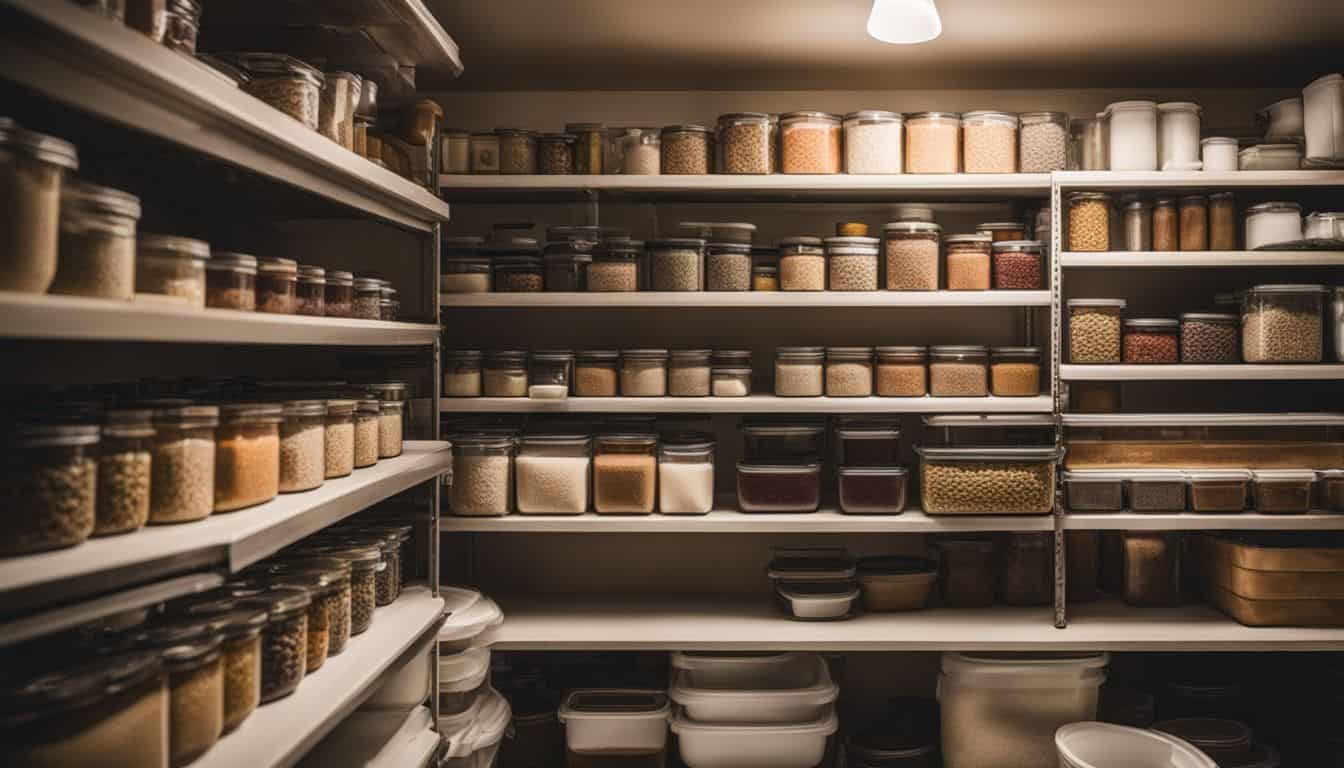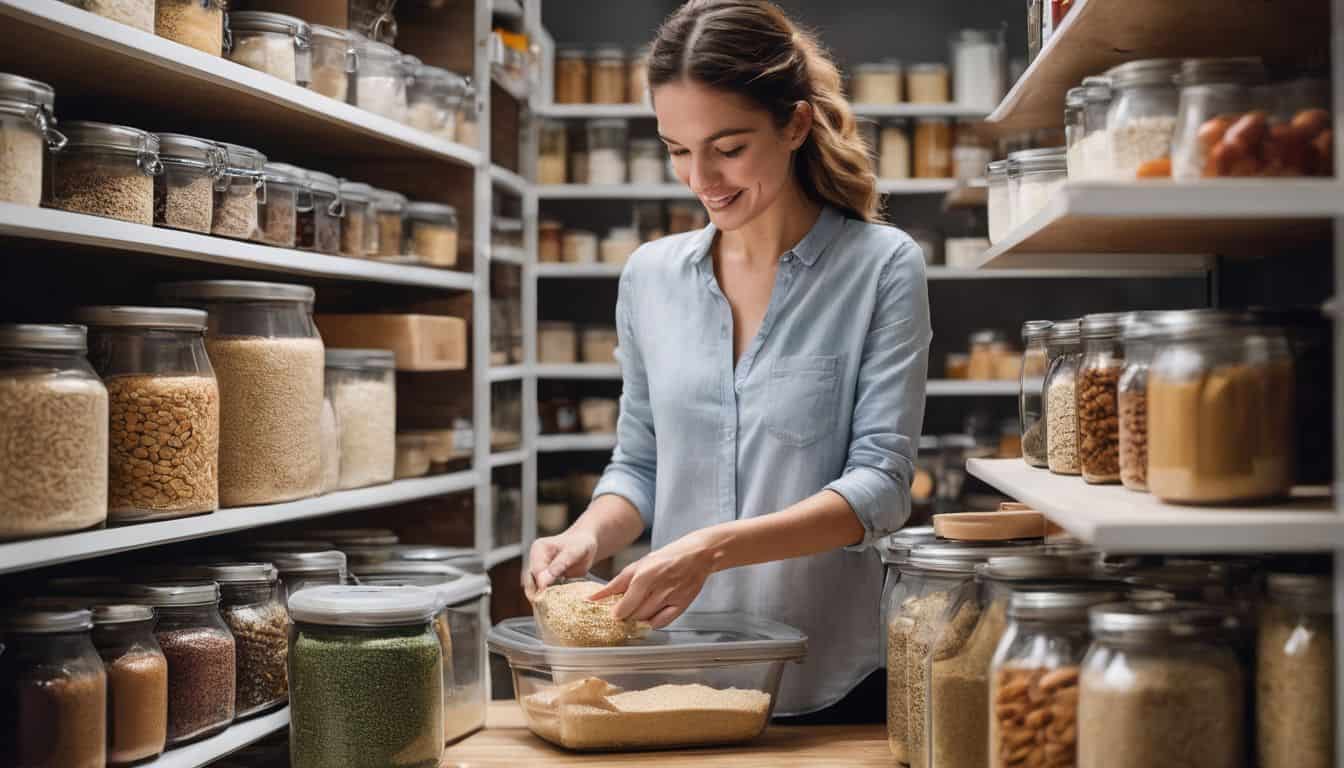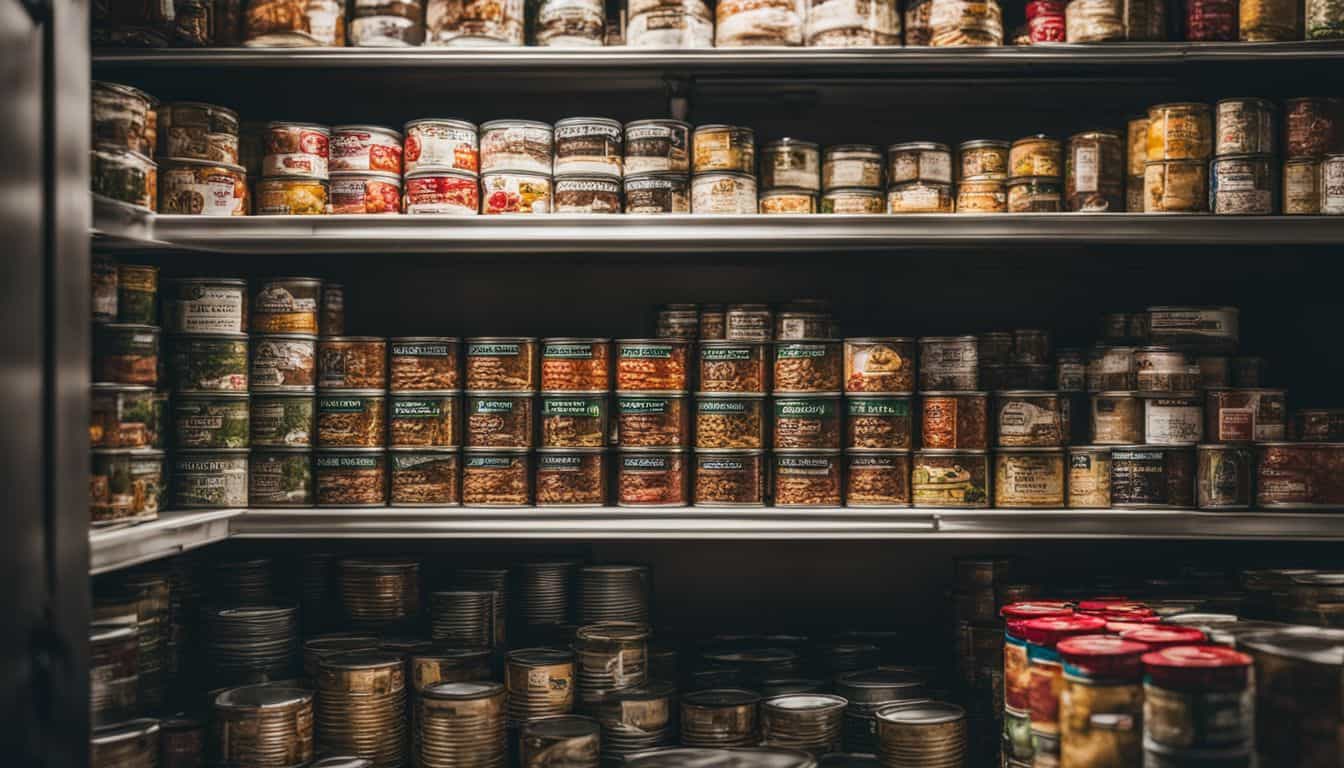Looking for long-term food storage methods? You’re not alone! With the unpredictability of our surroundings and potential emergency situations, many of us are realizing the importance of finding reliable methods to safeguard our precious food supply.
Guess what? In just three easy steps – packaging dry foods properly, using airtight containers, and treating your food right – you can store food effectively for extended periods. This article is here to guide you through various techniques and best practices to fortify your pantry safely, making sure you’re always ready for any situation.
Are you excited to learn these insider tips? Let’s get started!
Key Takeaways
- Long – term food storage is crucial for emergencies and ensuring a steady food supply.
- The basics of long – term food storage include packaging dry foods properly, using airtight containers, and storing in cool, dry places.
- Guidelines for safely storing food long – term include maintaining a stable temperature, rotating stock regularly, and keeping the storage area dry.
- Canned foods, dried beans, pasta, grains, nuts and seeds are good options for long – term food storage.
The Importance of Long-Term Food Storage
Long-term food storage is crucial for ensuring that you have a steady supply of food in times of emergencies or natural disasters. It provides peace of mind knowing that you are prepared and can sustain yourself and your family even when access to fresh food is limited.
What is long-term food storage?
Long-term food storage means keeping food safe for many years. It is key in getting ready for any emergency. We fill our shelves with high-calorie foods that last long. These include canned, dried and bulk foods.
If we pack and store them right, they can stay good for 30 or more years!
Why should you have a food storage?
You never know when an emergency will happen. Having a food storage is a smart move. This is important for being ready in case of natural disasters or sudden life changes. Long-term food storage can save your life if you can’t find other food to eat.
Also, it helps you deal with everyday problems too. For example, if there’s bad weather and stores are closed, your stored food comes into use. Plus, keeping high-calorie foods in this store keeps you healthy even when fresh items run out which ensures good public health and survival!
Understanding the Basics of Long-Term Food Storage

Storing food for a long time is not hard. It needs some care and steps that are easy to follow. The first thing you need is food with a long shelf life. This includes things like canned goods and dried foods.
Big bags of rice, pasta, or beans also work well.
To keep your stored food safe, note the conditions where you store it. Cool and dry places are best. Heat can hurt the quality of your food over time. If there’s too much moisture in the air, mold might grow on your food! Another big part of storing food for a long time is packaging methods.
Mylar bags and cans can help block oxygen out.
Oxygen absorbers can also help do this job well when put inside storage containers with the foods.
Food safety should be your main focus as spoiled or bad food won’t be any good to use even if they remain fine on their outer looks.
You also want to make sure what you’re storing will hold its taste over time so that when it’s opened after many years it still tastes good as fresh!
Guidelines for Safely Storing Food Long-Term
When storing food long-term, it is essential to maintain a stable temperature, rotate your stock regularly, and keep the storage area dry.
Maintaining a stable temperature
Proper temperature control is essential for safely storing food long-term. It helps prevent the growth of bacteria and reduces the risk of food poisoning. To keep high-risk foods safe, it’s important to store them at a temperature below 5°C or above 60°C.
Refrigeration is crucial for maintaining food safety, so make sure your refrigerator is set at the right temperature (below 5°C). Consistently keeping your food chilled not only keeps it fresh but also slows down bacterial growth.
Using the refrigerator drawers can help maintain a consistent temperature, making it suitable for long-term food storage and ensuring its safety. So remember, proper temperature control plays a significant role in preserving the quality and safety of your stored food.
Rotating your stock
Rotating your stock is a crucial part of long-term food storage. It means using the oldest items first and replacing them with newer ones. This helps ensure that your stored food stays fresh and doesn’t go bad.
By practicing the FIFO method (First In, First Out), you can keep track of expiration dates and use older products before they expire. Date labeling everything in your food storage is important so that you know what needs to be used soon.
Proper rotation prevents waste and saves money by avoiding spoilt or expired food. It also helps maintain an organized pantry, making it easier to find what you need when you need it.
Keeping it dry
To safely store food for the long term, it’s crucial to keep it dry. This helps prevent mold, bacteria growth, and other forms of spoilage. When storing raw food in the refrigerator, make sure to seal it tightly in containers to avoid any liquid transfer or contamination.
It’s also important to store raw foods below cooked foods to prevent meat juices from dripping onto other items and causing cross-contamination. For dry goods storage, create a cool and well-ventilated storeroom with temperatures between 50°F and 70°F.
Lower temperatures contribute to longer storage times for these items. Remember that using airtight containers is the best option for long-term storage of dry foods as they minimize exposure to oxygen and help prolong shelf life.
Foods with a Long Shelf Life
Canned foods, dried beans, pasta, grains, nuts and seeds – these are just a few examples of foods that can last for years in your pantry. Curious to learn more about the best options for long-term food storage? Read on!
Canned foods
Canned foods are an excellent option for long-term food storage. They have a shelf life of 2-5 years from the manufacture date, making them a reliable choice. It’s important to store canned foods at stable temperatures below 75°F to prevent nutrient loss.
There are high-acid and low-acid canned goods, with different expiration dates. High-acid foods should be used within 18-24 months, while low-acid foods can last anywhere from 2-5 years if stored properly.
So, stocking up on a variety of canned foods can ensure you have nutritious options available for an extended period of time.
Dried beans, legumes, and lentils
Dried beans, legumes, and lentils are great foods to have in your long-term food storage. They can last for a really long time if stored correctly. When packaged and stored properly, dry beans can stay good for 25 to 30 years! That’s a lot of time! Even if you just use normal polyethylene bags, they can still last for about a year or even longer.
But if you want them to last indefinitely, it’s best to store them in airtight containers like mylar bags or glass jars. Don’t worry too much about the expiration date on the packaging – dried beans and lentils can usually last forever if you store them right.
Pasta
Dry pasta is a great option for long-term food storage because it has a shelf life of about 3 years in its original packaging. However, if you repackage dry pasta into a food-grade container, you can extend its shelf life even further.
In fact, if stored correctly, dry pasta can last for over 10 years! It’s important to note that different types of pasta have different shelf lives, but some types can be stored for 1-2 years past their expiration date.
So when building your long-term food storage supply, don’t forget to include some pasta. It’s versatile and will provide you with a delicious meal during challenging times.
Grains
Grains are an important part of a long-term food storage plan because they have a long shelf life and provide essential calories for sustenance. Wheat, rolled oats, white rice, corn or cornmeal, pearled barley, and brown rice are common grains that can be stored for extended periods.
For example, wheat can last over 30 years when stored correctly. Including grains in your food storage supply can help you thrive during times of food scarcity or emergencies. They are not only versatile but also provide the necessary energy to keep going in challenging situations.
So be sure to include a variety of grains like cereal, pasta, quinoa, millet, buckwheat, amaranth and more for a well-rounded and sustainable long-term food storage plan.
Nuts and seeds
Nuts and seeds are great options for long-term food storage. They have a long shelf life and can last for months or even years if stored properly. When it comes to nuts, you can store them in the pantry for up to 3 months, in the refrigerator for 1 year, or in the freezer for up to 3 years.
Seeds can also be stored in the refrigerator for about 6 months or in the freezer for up to 1 year. Storing nuts and seeds in the freezer helps keep them fresh for longer periods of time.
Some types of nuts like almonds, pecans, pistachios, and walnuts are rich in unsaturated fatty acids and provide good nutrition. To maximize their shelf life, vacuum sealing is an effective method that you can use when storing nuts and seeds.
Herbs and spices
Herbs and spices are important ingredients to have in your pantry, especially for long-term food storage. While they don’t have a long shelf life like some other foods, they can still be stored for a reasonable amount of time.
Whole spices, herb leaves, and flowers can last for 1-2 years if you keep them in their original packaging. Spice blends will retain most of their flavor for up to 2 years. Dried leafy herbs will still have good flavor for about 1-3 years.
And seeds will stay flavorful for around 4 years. So while herbs and spices may not last as long as some other items, it’s still worth having them on hand to add flavor to your meals during an emergency or when you’re stocking up on supplies.
Dried fruit
Dried fruits are a great option for long-term food storage. They have an extended shelf life because most of the moisture has been removed during the drying process. For example, Sunrise Fresh dried fruits can last up to 18 months! In general, dried fruits can be stored for about a year at 60ºF and six months at 80ºF.
If you store them in air at near optimal temperatures, they can last up to 16 weeks. To further extend their shelf life, you can vacuum seal dried fruits. This will help keep them fresh and tasty for even longer periods of time.
So if you’re looking for delicious and nutritious snacks that will last in your survival pantry, don’t forget to stock up on some dried fruit!
Vegetables
Some vegetables, like beets, turnips, rutabagas, carrots, parsnips, and ginger, can last a long time without going bad. You can store these vegetables in the fridge for a while to keep them fresh.
Other vegetables that stay fresh for months include pumpkins, sweet potatoes, cabbage, spaghetti squash, carrots, and onions. When storing vegetables for the long term, it’s important to consider where and when they were harvested as well as the temperature and humidity levels.
If you wrap your veggies in metallized polyester or polyethylene wrap and keep them cool, they can last for five years or more.
Methods for Building a Long-Term Food Storage Supply
Discover the best ways to build a long-term food storage supply and ensure you’re prepared for any situation.
Buying in bulk
When it comes to building a long-term food storage supply, buying in bulk is a smart approach. Purchasing your pantry essentials in large quantities allows you to stock up on items that have a long shelf life and can sustain you for an extended period of time.
Buying in bulk is cost-effective, as it often comes with discounted prices compared to buying individual packages. It’s also convenient because you won’t need to worry about running out of essential items frequently.
Plus, having a surplus of food items gives you peace of mind knowing that you’re prepared for emergencies or natural disasters. By investing in bulk groceries, you’re creating a long-lasting food supply that will support you when needed the most.
Growing your own food
Growing your own food is a smart and rewarding way to build up your long-term food storage supply. By growing your own fruits, vegetables, and herbs, you have control over the quality and variety of the food you consume.
Plus, it can save you money in the long run. When growing your own food for storage, it’s important to consider factors like crop yield and preservation techniques. It’s recommended to grow more crops than you think you’ll need to account for potential spoilage during storage.
This way, you can ensure a sustainable source of fresh produce for yourself and your family while also increasing self-sufficiency and food security.
Packaging your own dry foods
Packaging your own dry foods is a great way to build up your long-term food storage supply. You can use recycled plastic bottles or tightly sealed containers to keep your dry foods fresh for a longer time.
By packaging and storing dehydrated foods properly, you can maintain their quality over an extended period. It’s important to use airtight containers, like Mylar bags or food-grade buckets, and consider using oxygen absorbers or moisture control methods to ensure shelf stability.
With these DIY methods, you can save money and have peace of mind knowing that you have enough food in case of emergencies or natural disasters.
Buying from local producers and preserving
Supporting local farmers and preserving food are two effective methods for building a long-term food storage supply. By buying from local producers, not only are you supporting your community, but you’re also ensuring the freshness and quality of the produce you store.
Local produce often has a shorter time between harvest and purchase, meaning it can have a longer shelf life when properly preserved. You can preserve food through various methods like canning, freezing, drying, root cellaring, fermenting, vacuum sealing, dehydrating,and pickling fruits and vegetables.
These preservation techniques help extend the shelf life of your stored food while retaining their nutritional value. So by buying from local producers and preserving your own food, you’ll have a well-rounded long-term storage supply that is both sustainable and delicious.
Containers and Treatment for Long-Term Food Storage
Choosing the right containers for long-term food storage is crucial to ensure your supply remains fresh and safe.
Best containers for storing food
When it comes to storing food for the long term, choosing the right containers is crucial. Here are some of the best options:
- Plastic buckets: Plastic buckets are an inexpensive choice for storing dry food products. They are durable and can provide excellent protection against moisture, pests, and air exposure.
- Mylar bags: Mylar bags are made of a flexible and heat-sealable material that helps to preserve the freshness of food. They provide a barrier against oxygen, light, and moisture.
- Food-grade buckets with gamma seals: These buckets come with airtight gamma seal lids that make them easy to open and close while maintaining freshness. They are suitable for storing bulk grains, dry goods, and other long-lasting foods.
- Glass jars: Glass jars are a great option for storing smaller quantities of food. They are non-reactive and do not absorb odors or flavors from stored food, ensuring the taste remains unchanged.
Proper treatment methods
I’ve found some great ways to properly treat your food for long-term storage. Here they are:
- Use dry ice for storing dry food products in plastic buckets.
- Make sure your food is stored in suitable, covered containers to keep it safe and fresh.
- Keep your raw or finished products in containers with controlled conditions.
- Transfer opened packages of sugar, dried fruits, and nuts to screw-top jars or airtight containers to protect them from pests.
Benefits of Having a Well-Stocked Pantry
Having a well-stocked pantry offers several benefits, such as saving money on groceries by buying in bulk and reducing waste from excessive packaging. It also saves time on weekly grocery trips and ensures you are prepared for emergencies or natural disasters with an ample food supply.
Saving money
Stocking up on long-term food storage supplies can actually help you save money in the long run. When you have a well-stocked pantry, it means you don’t have to make frequent trips to the grocery store.
By planning ahead and buying items in bulk or during sales, you can take advantage of lower prices and avoid impulse purchases. This allows you to create inexpensive meals using basic core ingredients from your pantry, which can be a great way to stretch your budget and save money.
Plus, by only purchasing items that will be consumed and organizing your pantry effectively, you can avoid waste and ensure cost-effectiveness. So not only does having a well-stocked pantry provide security and peace of mind, but it also helps you be more frugal with your food expenses.
Saving time on weekly tasks
Having a well-stocked pantry can be a real time-saver when it comes to weekly tasks. By having everything you need right at your fingertips, you won’t have to make as many trips to the grocery store, which means extra time saved.
Plus, when you plan and prepare meals ahead of time based on what’s in your pantry, you can streamline your cooking process and avoid last-minute frantic trips to the store. So not only will having a well-stocked pantry save you time, but it can also help with meal planning and budgeting too.
It’s all about convenience, efficiency, and organization when it comes to saving time on those weekly tasks!
Being prepared for emergencies or natural disasters
I understand the importance of being prepared for emergencies or natural disasters. Having a well-stocked pantry can make a big difference in these situations. It’s recommended to have at least a 3-day supply of food on hand in case of a disaster, and non-perishable foods are essential for emergency kits.
Including canned foods in your emergency kit is important too, as they have a long shelf life and provide necessary nutrients. By having these items ready, you can ensure that you and your loved ones are taken care of during challenging times.
Reducing waste from packaging
One important aspect of having a well-stocked pantry is reducing waste from packaging. By being mindful of the packaging materials we use, we can minimize our impact on the environment and make more sustainable choices.
For example, buying food from bulk bins allows us to save money and reduce food waste, as it eliminates the need for excessive packaging. Additionally, using reusable containers like glass or plastic can help us cut down on kitchen waste while still keeping our food fresh and protected.
These simple changes in our shopping habits and kitchen practices can have a big impact on reducing unnecessary waste.
How to Stock Up on Long-Term Food Storage
To stock up on long-term food storage, consider buying more packages, purchasing in bulk, buying bulk from local producers and preserving, or growing your own food. These methods will help ensure you have a well-stocked pantry for any situation that may arise.
Buy more packages
One way to stock up on long-term food storage is by buying more packages of food. When purchasing these packages, it’s important to choose high-quality dry food products with low moisture content.
This will ensure that the food stays nutritious and edible for an extended period of time, even up to 30 years or more. Buying in bulk can also be a cost-effective strategy for long-term storage.
So, if you want to build an emergency pantry or have provisions for survival situations, consider buying more packages of dry and packaged foods.
Buy in bulk
Buying in bulk is an excellent way to stock up on long-term food storage supplies. When you buy in bulk, you can save money because the price per unit is usually lower than buying individual packages.
Additionally, many regular grocery stores offer bulk packages of pantry staples like grains, beans, and pasta. These bulk quantities are cost-effective and have a long shelf life, making them perfect for building up your food storage supply.
By purchasing in bulk, you can get more value for your money and ensure that you have enough food to sustain yourself during emergencies or natural disasters. So next time you’re at the store, consider buying in bulk to start building your long-term food storage.
Buy bulk from local producers and preserve
Buying bulk from local producers and preserving food is a smart way to stock up on long-term food supplies. When you buy in bulk, you can often get better prices and support local farmers at the same time.
Plus, it allows you to have a variety of foods on hand that can last for a long time. To make your bulk purchases last even longer, consider preserving them through methods like canning, freezing, or dehydrating.
This will help extend the shelf life of your food and ensure its availability during emergencies. By buying in bulk from local producers and preserving your food, you can save money and have peace of mind knowing that you’re prepared for any situation.
Grow your own food
Growing your own food is one of the best ways to ensure a long-term food supply. It’s not only satisfying and rewarding, but it also gives you control over what you eat and how it’s grown.
By gardening at home, you can grow a variety of fruits, vegetables, and herbs that you and your family enjoy. Plus, you can choose organic methods to keep your produce free from harmful chemicals.
Whether you have a small backyard or just a few containers on a balcony, growing your own food can provide self-sufficiency and security in times of need. So get your hands dirty and start cultivating your own little piece of paradise!
The Best Methods for Long-Term Food Storage
Discover the top techniques for long-lasting food storage, ensuring your pantry is well-stocked and prepared for any situation. Click here to learn more!
#10 cans
I love using #10 cans for my long-term food storage. These cans are specially made to keep food fresh for a really long time. They work best for storing foods that have low moisture and low oil content.
What I like about them is that they can keep my food cool, safe from bugs and rodents, and prevent rust too. And guess what? When I store my food in #10 cans properly, it can last for 30 years or even longer! No wonder they’re so commonly used for storing bulk food over a long period of time.
Food-grade buckets
Food-grade buckets are an excellent choice for storing your long-term food supply. These buckets, made of HDPE (number 2), are specifically designed for food storage and can help extend the shelf life of your dry food products such as grains, beans, flour, and dry milk.
They’re practical because they allow you to store large quantities of food in one container. Having properly stored food in these buckets is also beneficial during emergencies or natural disasters when access to fresh food may be limited.
So if you’re looking for a reliable and efficient way to store your long-term food items, consider using food-grade buckets.
Mylar bags
Mylar bags are a great option for long-term food storage. They are considered the best method for storing dry foods like rice, beans, and flour. With proper storage, these foods can last up to 20 years in Mylar bags.
These bags are made of a strong polyester film called BoPET, which creates a barrier against light, moisture, and oxygen. This helps preserve the quality of the food and prevents spoilage.
That’s why many preppers and people concerned about food security use Mylar bags for their long-term storage needs. So if you want to ensure your food stays fresh for a long time, consider using Mylar bags for your pantry storage or emergency preparedness supplies.
PETE bottles
PETE bottles are a great option for long-term food storage. They work well for storing grains and legumes, as well as water. You can even use oxygen absorbers with PETE bottles to store wheat, corn, and dry beans.
These bottles are small and easy to manage, making them convenient for storing your emergency food supply. It’s good to know that PETE bottles are made from the same plastic used in foil pouches, so you can trust their durability.
When it comes to long-term food storage, PETE bottles are definitely a reliable choice.
Conclusion on Long-Term Food Storage Methods
In conclusion, long-term food storage is important for both everyday life and emergency situations. By understanding the basics of food storage and following guidelines for safe practices, you can build a well-stocked pantry that will save you money, time, and ensure you’re prepared for any situation.
With methods like buying in bulk, growing your own food, or packaging your own dry goods using proper containers like #10 cans or Mylar bags, you’ll be on your way to winning at long-term food storage.
So start preparing today and have peace of mind knowing you have a reliable food supply when you need it most.
FAQs on Long-Term Food Storage Methods
1. Why is long-term food storage important?
Long-term food storage is important because it helps you be prepared for emergencies, natural disasters, or unexpected situations where access to fresh food may be limited.
2. What are the three ways to win in long-term food storage?
The three ways to win in long-term food storage are choosing the right containers and packaging, using proper preservation methods such as canning or freeze-drying, and rotating your stored food regularly to ensure freshness.
3. How long can stored food last?
The shelf life of stored food depends on factors like the type of food, storage conditions (temperature, humidity), and packaging method. Generally, properly stored canned foods can last 1-5 years, freeze-dried foods can last 25+ years, and dry pantry staples like rice or beans can last several years.
4. Can I store any type of food for a longer time?
Not all types of foods are suitable for long-term storage due to their perishable nature or potential spoilage risks. It’s best to focus on storing foods with low moisture content like grains, legumes, powdered milk, canned meats/fish/fruits/vegetables.
5. How can I ensure my stored food stays safe and edible over time?
To ensure your stored food stays safe and edible over time:
– Store in a cool (below 70°F), dark place away from direct sunlight.
– Use appropriate containers that are airtight and prevent pests from entering.
– Regularly check for signs of spoilage (odor change





Leave a Reply